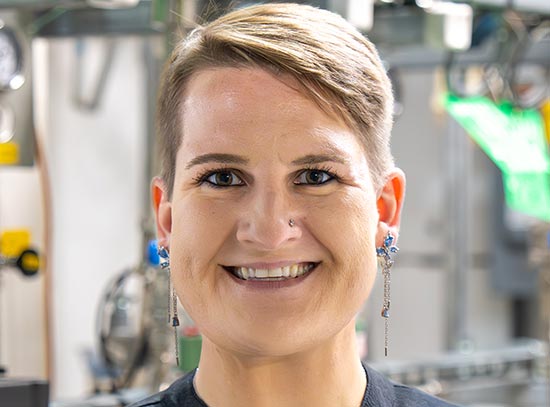Latest Supercomputer Calculations Support the Six-Quark Theory
February 8, 2008
Note: This is an informational posting only, not a Brookhaven press release.
A new calculation, reported in the January 25, 2008 issue of Physical Review Letters, confirms the six-quark theory of particle-anti-particle asymmetry. This is the first complete calculation of this phenomenon to employ a highly accurate description of the quarks that adds a fifth dimension beyond those of space and time.
This result allows recent experiments studying the decays of bottom quarks to be compared with earlier, strange quark experiments. This comparison agrees with the predictions of the Standard Model of particle physics and implies that the particle-anti-particle asymmetries (technically known as "CP-symmetry violation") seen in these two different decay processes have a common origin.
This research was carried by physicists from the U.S. Department of Energy's Brookhaven National Laboratory (BNL), Columbia University, the University of Connecticut, Edinburgh University, University of Southampton, and the RIKEN BNL Research Center (RBRC) using powerful, massively parallel supercomputers specially constructed to perform these calculations and capable of tens of trillions of arithmetic operations per second. The work was funded by the Particle Physics and Astronomy Research Council in the UK (now the Science & Technology Facilities Council), the RIKEN Laboratory in Japan, and the Office of High Energy Physics within the U.S. Department of Energy's Office of Science.
Earth, our solar system, our galaxy - and likely the entire visible universe - are made of matter, not anti-matter. While it is easy to create anti-matter in the particle collisions that take place in large particle accelerators, the anti-particles produced there immediately annihilate with matching particles in the surrounding normal material, disappearing into a burst of light and other particles whose energy quickly dissipates.
Could we distinguish a mirror universe made of anti-matter instead of matter, in which research workers made of anti-matter could create fleeting examples of matter in their anti-matter accelerators? If there were a perfect symmetry between our "matter" universe and one composed of anti-matter, what determines which type of universe we occupy?
In a Nobel Prize-winning experiment performed in 1964 at Brookhaven Lab, small differences were discovered between the laws obeyed by particles and anti-particles. These clearly distinguish a matter universe from an anti-matter universe.
Accommodating such a matter-anti-matter asymmetry into a fundamental theory is not easy. A theory made from only two pairs of fundamental quarks, the so-called up-down pair and the charmed-strange pair cannot easily allow such matter-anti-matter differences. Only when a third pair of quarks, the top-bottom pair, are included does the theory support this particle anti-particle asymmetry. This connection between the number of types of quarks and matter-anti-matter asymmetry was discovered by Kobayashi and Maskawa, who made a compelling case for the existence of the then-undiscovered top quark on this basis. The resulting theory, with the now-known three quark pairs, offers a very beautiful explanation for matter-anti-matter asymmetry. Is it correct?
Since the six-quark theory supports only a single type of matter-anti-matter asymmetry, every signature for such an asymmetry must be connected to every other. Thus, the asymmetry seen in the decays of mesons containing bottom quarks can be related to the matter-anti-matter asymmetry seen in the decay of mesons containing strange quarks. However, to accurately link the recent bottom quark experiments carried out at the B-Factories at SLAC (Stanford, CA) and at KEK (Japan) with the 1964 Brookhaven experiment, one must have a quantitative understanding of the quarks that appear in tightly bound combinations that make up the particles being studied.
Fortunately, the calculation of such decays is now possible using very powerful supercomputers and a computational treatment of the quarks known as lattice QCD. (QCD stands for quantum chromodynamics, the theory of the strong interaction between quarks and gluons - indirectly seen particles that act to hold the quarks together. The term lattice refers to the grid of points in space-time used as a framework for the numerical calculation.)
The actual phenomenon calculated is a surprising oscillation between a K meson (made up of a strange quark and an anti-down quark) and its anti-particle, which occurs roughly 5 billion times per second. Unfortunately, the aspect of this oscillation that distinguishes particles and anti-particles is very subtle and would not be present at all if the mass of the down quark, which is already very small, were zero. Since there are many other, much larger possible sources of such oscillations, a very delicate calculation is required which treats the light down quark accurately and can distinguish between the correct and the incorrect oscillation mechanisms.
A formulation sufficiently accurate to perform this calculation correctly was invented in the early 1990s. In this approach normal spin-1/2 particles, such as electrons and quarks, are allowed to move in four, not three, spatial dimensions so that space-time acquires a fifth spatial dimension. In contrast to the standard space-time dimensions, which are presumed to extend to infinity, this fifth dimension is bounded, ending in two four-dimensional boundaries, similar to the two-dimensional top and bottom of a three dimensional cardboard box. When spin-1/2 particles travel into this fifth dimension, they behave as very massive particles - so heavy that they would not have been seen in experiments to date. However, when they move along the two boundaries, these particles appear physical. The particles on one boundary spin in a right-handed sense and those on the other carry a left-handed spin. The spin-1/2 particles realized using this new approach are called domain wall fermions, and this method provides just the accurate description of the quarks that is needed for the oscillation calculation described above to be reliably carried out.
The calculation reported here builds upon earlier, pioneering, lattice QCD studies of this phenomenon carried out over the past 20 years in Europe, Japan, the U.S. and the UK. However, it is only with this five-dimensional domain wall fermion method, made practical by the current massively parallel supercomputers, that it has become possible to accurately incorporate the subtleties implied by the very small quark masses and to reach a level of accuracy comparable to the current experiments.
The result suggests that the six-quark theory correctly describes the matter-anti-matter asymmetry seen in the decays of both the bottom and strange mesons. If the strange and bottom experiments are combined with the less demanding theory for the bottom meson system, the oscillation amplitude for the strange mesons (a quantity call BK) can be determined to be 0.78 with an error of 0.09. The result of this new calculation gives an entirely consistent value of 0.72 for this same quantity with an error of 0.04.
Of course, there are still many important questions that need to be answered. Calculations of even greater numerical accuracy can reduce the errors and permit an even more challenging comparison between theory and experiment. Of great interest is the possibility that this difference between matter and anti-matter explains why we are made of matter instead of anti-matter. Perhaps as our universe cooled after the Big Bang, this difference between particles and anti-particles pushed the cooling universe in the "matter direction," causing us to ultimately be made of matter not anti-matter?
Unfortunately, even though the six-quark theory explains all experiments carried out to date, its intrinsic asymmetry between quarks and anti-quarks appears to be too weak to account for the matter-anti-matter asymmetry implied by our observable universe. Entirely new ideas and phenomena may well be required before this puzzle is understood.
2008-10744 | INT/EXT | Newsroom









